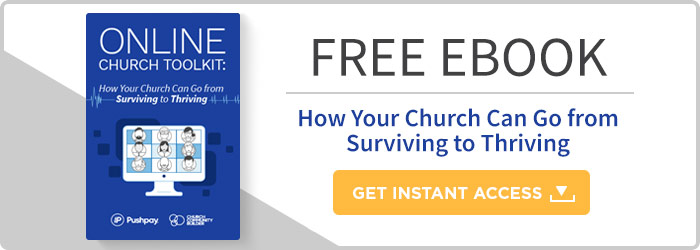Should You Livestream Your Service or Just Record It? The Pros and Cons
Updated April 8, 2024 |
As churches explore ways to take ministries online, livestreaming is one of the first solutions that comes to mind. For years that’s been one of the main ways churches have accommodated those who can’t attend services in person.
But as your staff works hard to facilitate live services in an empty sanctuary every week, you may begin to wonder: can we just record this?
Recording and livestreaming are both legitimate ways to facilitate an online experience, but they each have strengths and weaknesses you’ll want to consider. Normally, churches wouldn’t look at these as either/or options, but when nobody is sitting in your pews, they start to look pretty similar.
Here are the pros and cons of each choice.
LEARN MORE ABOUT LIVESTREAMING WITH RESI
The pros and cons of livestreaming
Livestreaming is less convenient (for staff and church members), but it also does a better job of facilitating an online community.
Pro: It creates a shared experience
When you add livestreaming to an in-person gathering, it allows church members who can’t physically attend your church to feel like they’re still participating. They’re worshipping with you. They’re experiencing your teaching in the moment. It’s all raw and unedited, and it’s an experience your congregation has together.
Pro: You can make it interactive
When everyone watches your service at the same time, there are more opportunities for interaction. If you go live on Facebook or Instagram, people can “react” to specific moments to share how they felt about what you said or did with everyone else who’s watching. And of course, everyone can comment and interact with other people’s comments in real-time.
Livestreaming solutions on your website or in your church app can also allow chat, prayer requests, and other interactions. With Pushpay, you can take polls during the service to gauge how strongly your congregation agrees or disagrees with a statement and then share the results. You can also share fill-in-the-blank notes and contact cards, just like you would during your in-person service.
Pro: It gets more prominent placement in social media
“Going live” elevates your video in your followers’ newsfeeds on Facebook and Instagram. Live videos get prominent spots at the top, so they’re more likely to be seen by church members who forgot about your stream, and they’re easier for people to find.
Pro: It generates fear-of-missing-out
A livestream is an event, just like your regular in-person service. It only happens at a fixed time, so people won’t want to miss it. This creates a sense of urgency, which can increase the likelihood that a large number of people hop on to watch your livestream together.
Con: It increases strain on your website
When you use a livestream to supplement your in-person services, you probably won’t have a ton of people watching at once—just those who can’t make it to your campus. But when suddenly your whole church can’t be with you in person and watching live is the only way to participate in your service, you’re going to have a ton of people on your website and in your app all at once. This means two things:
- You need to invest in a good app and a strong website hosting platform
- You may be more at risk of experiencing technical difficulties
In the wake of the coronavirus pandemic, churches that were used to seeing at most a handful of concurrent visitors on their website suddenly had to prepare for hundreds or even thousands of people trying to load their website at once!
Con: It can be difficult for families with young children to participate
Imagine trying to participate in worship or watch a sermon with a toddler crawling all over you, or a baby crying in your ear. When young families attend in person, parents can fully participate because their kids are in the nursery or kidmin classes. At home, not so much. So they may have a hard time joining you at a fixed time.
Con: Technical difficulties are more likely to impact your congregation
As everyone flocks to your church website, that increased traffic may cause your site to crash. But even if you’re prepared with a good hosting platform, doing everything live means that there’s no way to edit out mistakes, and you have to correct technical issues on the spot. Meanwhile, your whole congregation is watching.
The pros and cons of recording your service
Recordings give you and your congregation more flexibility and can result in a higher quality video, but it has some shortcomings as well.
Pro: People can watch when it’s most convenient
One of the biggest advantages of recording your service is that people can watch it at any time. They can tune in while their kids are sleeping or after work. They can even break it up throughout their day, so your service fits into their schedule, whatever it looks like.
Pro: You have time for do-overs
Having a live audience puts a lot more pressure on your worship team, teaching pastor, the person doing announcements, and your tech team. When it’s all recorded, you can easily stop and reshoot something to work out the kinks and correct mistakes.
Pro: It spreads out the traffic to your website
When people can watch your service at any time, they’re not all going to hop on at the same time. If you don’t have the budget to upgrade your web hosting platform or invest in a quality church app, and you don’t want to host your service on Facebook (where people are very easily distracted), recording your service is a good way to reduce the strain on your tech infrastructure.
Con: There’s less opportunity for church interaction
If you post a recorded service on social media, people can still react to it and start conversations. But they won’t be reacting as it’s happening. And on your website or church app, you won’t have a live chat feed for comments, questions, prayer requests, and other interactions.
Con: It doesn’t feel like participation in an event
With a recording, your congregation won’t see how many other people are actively watching the service with them. Watching at any time makes your service more accessible, but it loses the sense of community.
Con: There’s no urgency
Livestreaming your service encourages everyone to hop online to watch your service at the same time. If people don’t get on at your service time, they miss out. Recordings are far more convenient, but knowing you can watch at any time may mean fewer people ultimately tune in to watch your service.
Can you do both?
Right now especially, churches need to create and encourage digital community. But you also want to make your teaching, worship, and important information as accessible as possible. Some people won’t be able to watch your livestream because of work, family, and other commitments. But for those who can, the shared experience and greater opportunity for interaction could make an important difference.
In an ideal world, your church would have a livestream and an archive of recorded sermons. But in the chaos of this public health crisis, your staff may need to weigh each option and decide what makes the most sense for your church right now.
The 6 Week Plan to Engaging and Retaining Easter Guests
Odds are, you’re so immersed in planning the actual event, that your Easter follow-up isn’t top of mind. To help with this, we’ve created a free ebook, Your 6 Week Plan for Retaining Easter Guests, to help you cross key initiatives off on your follow-up to-do list.
Featured Content
You May Also Like

